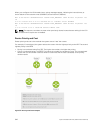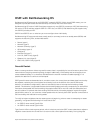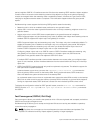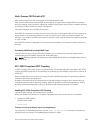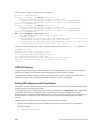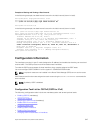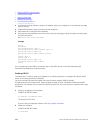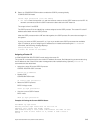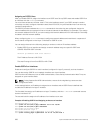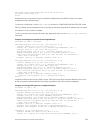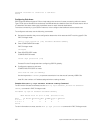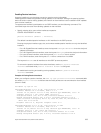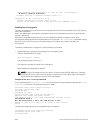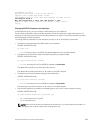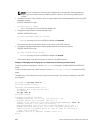
Assigning an OSPFv2 Area
After you enable OSPFv2, assign the interface to an OSPF area. Set up OSPF areas and enable OSPFv2 on
an interface with the network command.
You must have at least one AS area: Area 0. This is the backbone area. If your OSPF network contains
more than one area, configure a backbone area (Area ID 0.0.0.0). Any area besides Area 0 can have any
number ID assigned to it.
The OSPFv2 process evaluates the network commands in the order they are configured. Assign the
network address that is most explicit first to include all subnets of that address. For example, if you assign
the network address 10.0.0.0 /8, you cannot assign the network address 10.1.0.0 /16 because it is already
included in the first network address.
When configuring the network command, configure a network address and mask that is a superset of
the IP subnet configured on the Layer-3 interface for OSPFv2 to use.
You can assign the area in the following step by a number or with an IP interface address.
• Enable OSPFv2 on an interface and assign a network address range to a specific OSPF area.
CONFIG-ROUTER-OSPF-id mode
network ip-address mask area area-id
The IP Address Format is A.B.C.D/M.
The area ID range is from 0 to 65535 or A.B.C.D/M.
Enable OSPFv2 on Interfaces
Enable and configure OSPFv2 on each interface (configure for Layer 3 protocol), and not shutdown.
You can also assign OSPFv2 to a Loopback interface as a virtual interface.
OSPF functions and features, such as MD5 Authentication, Grace Period, Authentication Wait Time, are
assigned on a per interface basis.
NOTE: If using features like MD5 Authentication, ensure all the neighboring routers are also
configured for MD5.
In the example below, an IP address is assigned to an interface and an OSPFv2 area is defined that
includes the IP address of a Layer 3 interface.
The first bold lines assign an IP address to a Layer 3 interface, and theno shutdown command ensures
that the interface is UP.
The second bold line assigns the IP address of an interface to an area.
Example of Enabling OSPFv2 and Assigning an Area to an Interface
Dell#(conf)#int te 4/14/1
Dell
(conf-if-te-4/14/1)#ip address 10.10.10.10/24
Dell(conf-if-te-4/14/1)#no shutdown
Dell(conf-if-te-4/14/1)#ex
Dell(conf)#router ospf 1
Dell(conf-router_ospf-1)#network 1.2.3.4/24 area 0
Dell(conf-router_ospf-1)#network 10.10.10.10/24 area 1
650
Open Shortest Path First (OSPFv2 and OSPFv3)



